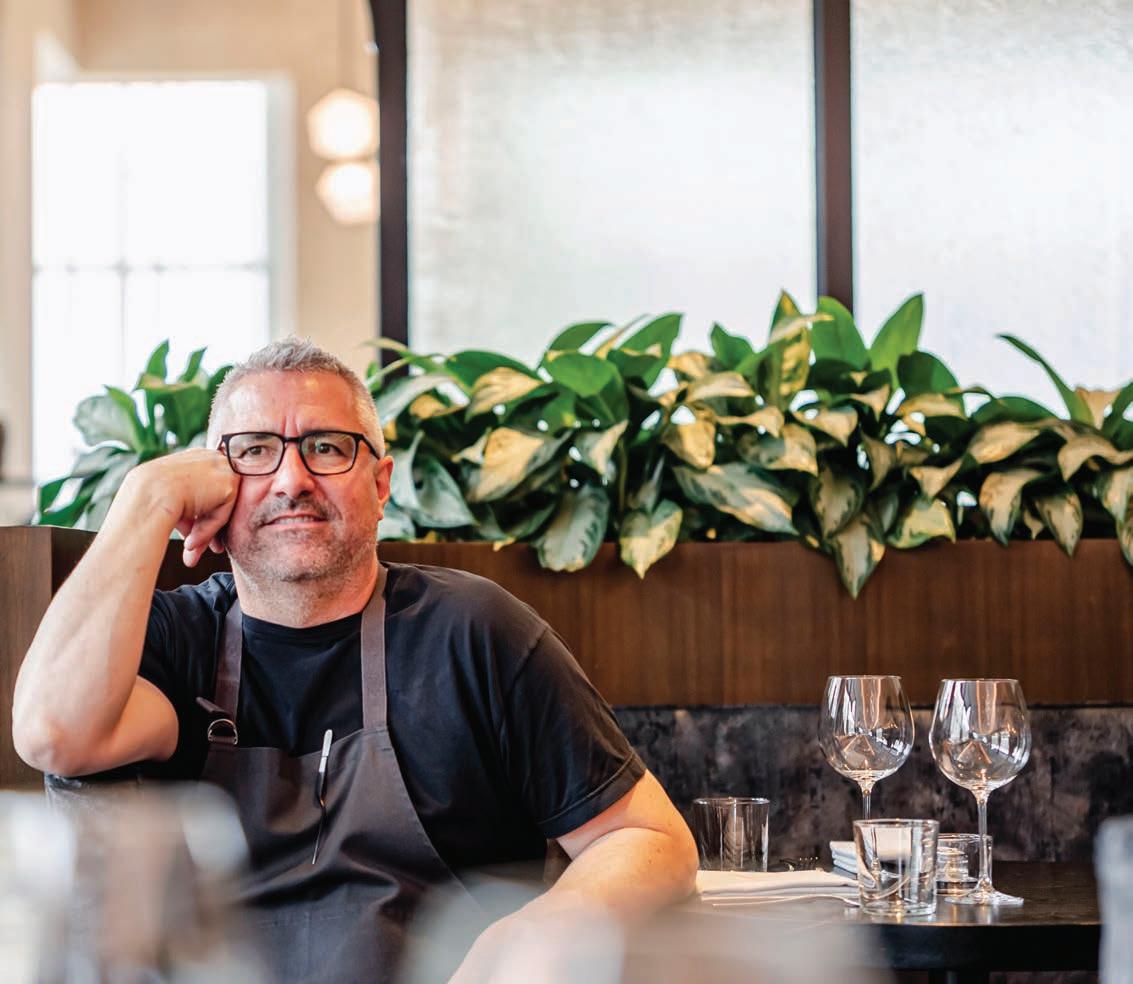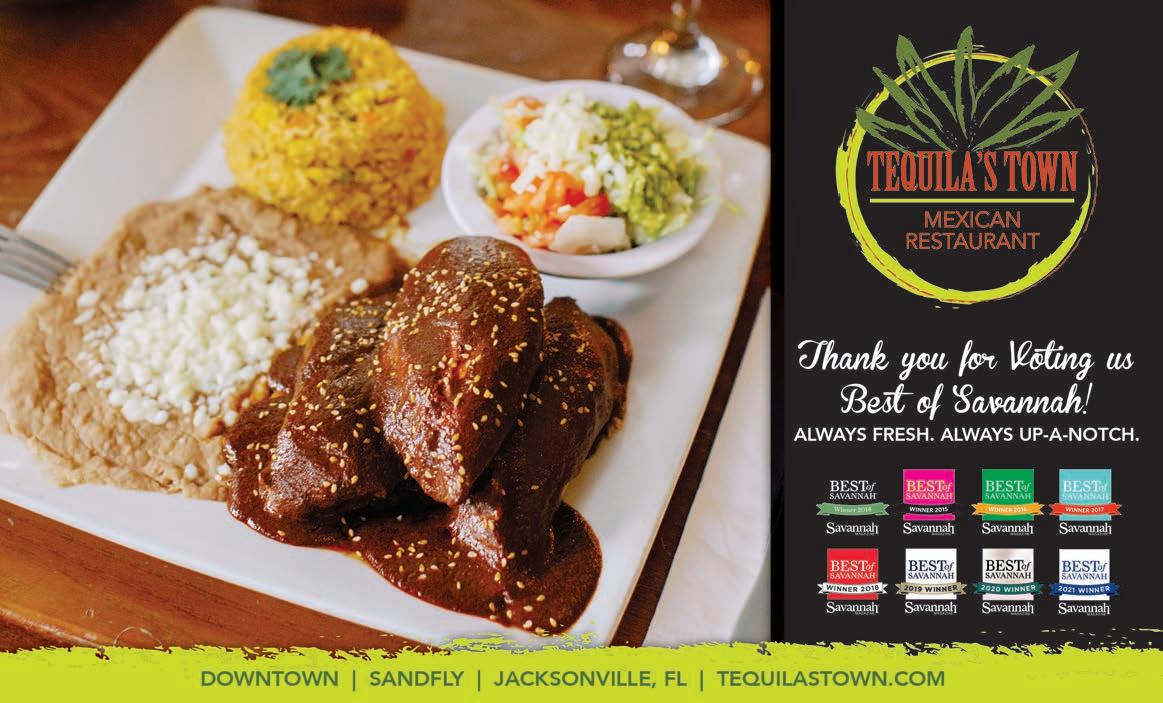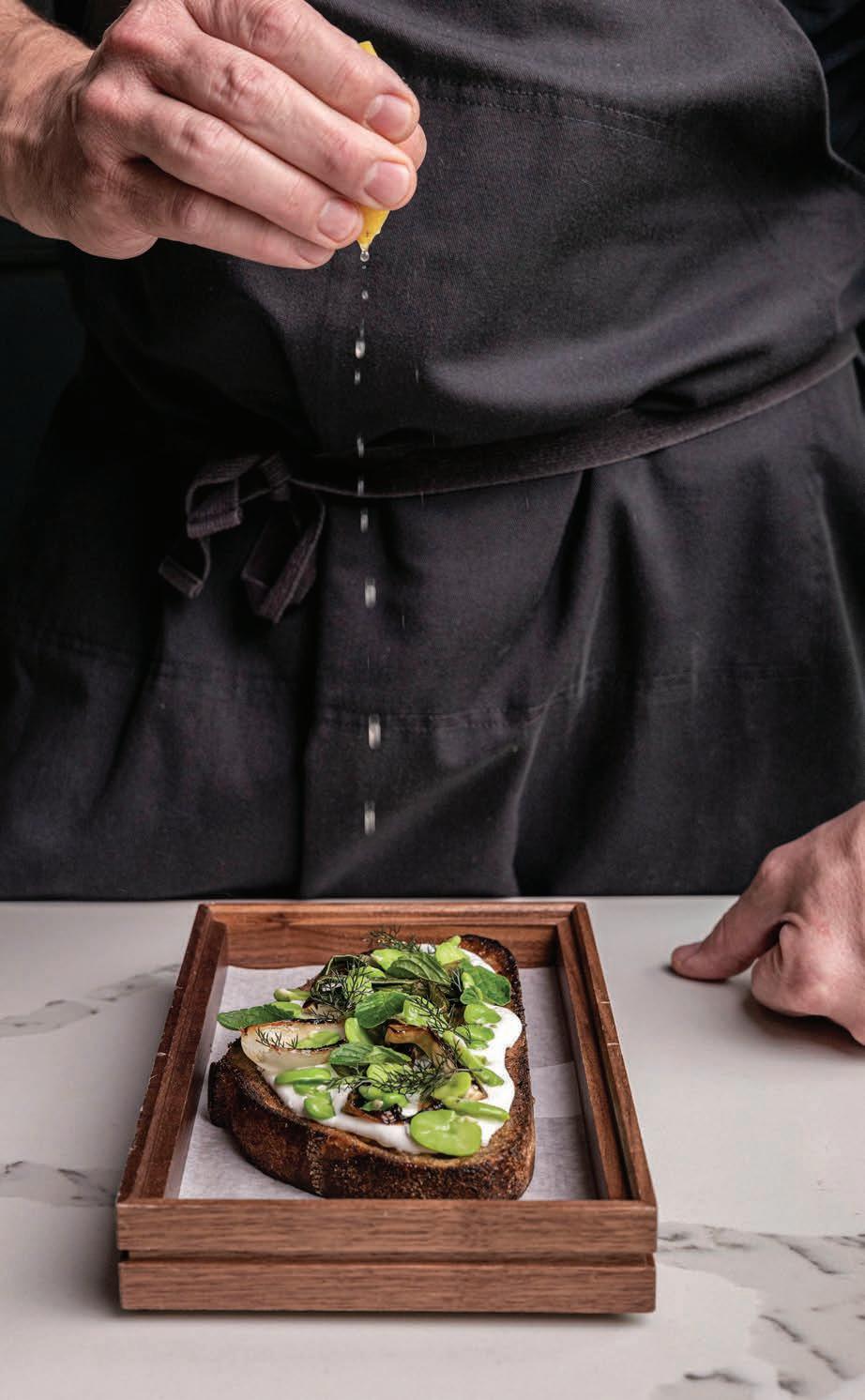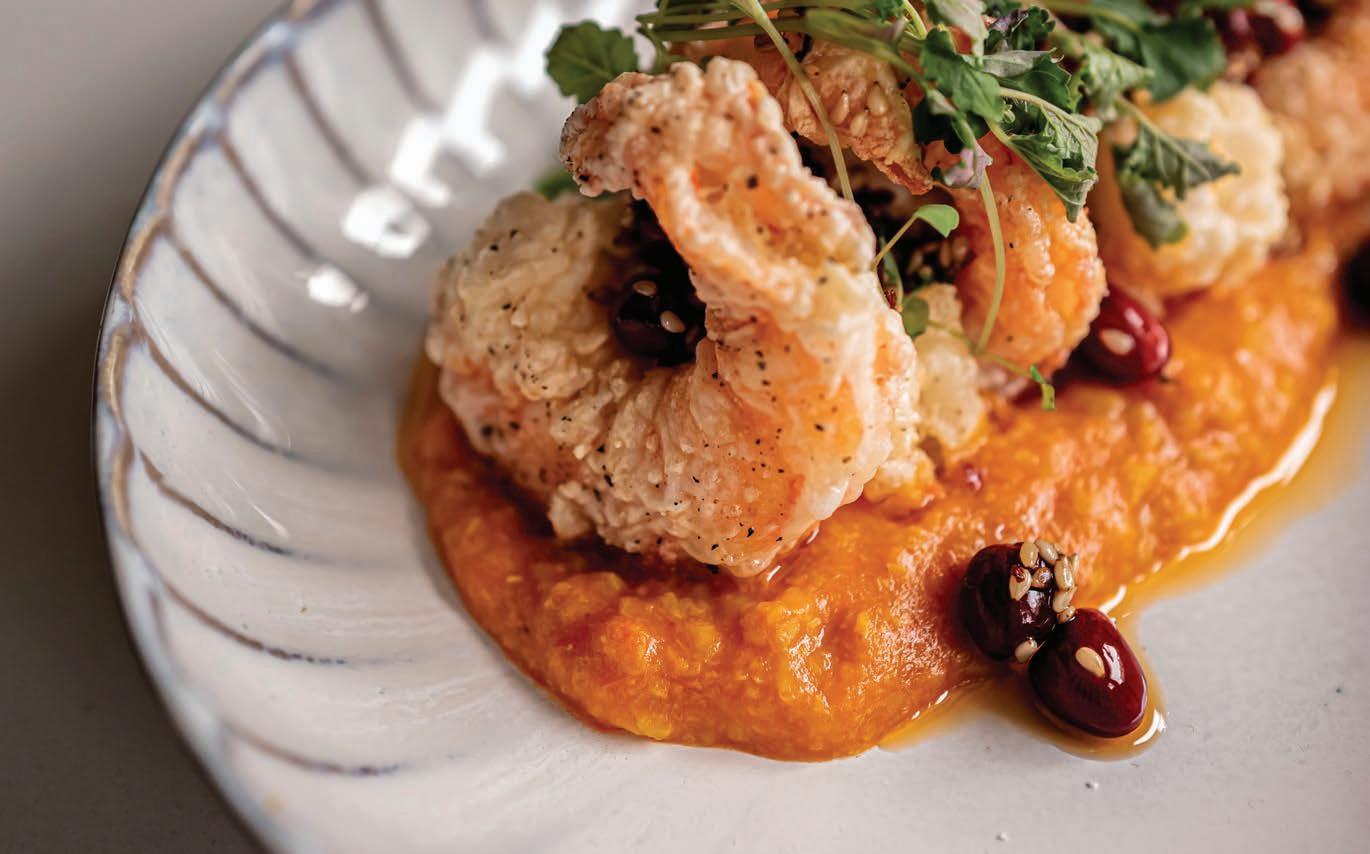
9 minute read
Fresh Take
TASTE TASTE SAVANNAH
Fresh Take
For Chef Robert Newton, “farm to table” isn’t just lip service
As told to SAVANNAH MAGAZINE // Photography by MICHAEL HRIZUK
ASK ROBERT NEWTON why a chef of his talents and resources would bother with a small, local farmers market (the Fleeting executive chef’s resume includes tenures at Le Cirque and Aquavit in New York, where he also owned and operated Seersucker Restaurant and Smith Canteen), and his response is emphatic: “You could do a whole piece on ‘why bother,’” he says.
We joined Newton at the Forsyth Farmers’ Market on a sunny Saturday morning to learn a few chef-approved tricks on navigating what’s in season. We expected a few clever strategies for how to pick the right produce, perhaps. What we didn’t expect was Newton’s fervor. He is an ardent supporter of farmers and their crops, and his restaurant, Fleeting, is rooted (pardon the pun) in micro-seasonality; it’s all about what’s freshest right here, right now. We followed him back to the kitchen, where we were equally delighted by the three dishes he prepared — and shared — using ingredients straight from the farmers market. Savor it all below. — SM
I WANT TO DEMYSTIFY AND HELP PEOPLE not feel intimidated at a farmers market. Most farmers I’ve been lucky enough to work with truly want to share more of what they grow. That’s not from a monetary perspective at all. It’s that they’ve grown it out of their earth on their farm, and they want to share it with people. If we don’t have farmers, we don’t have things to eat. We need people to be excited about growing things for us — and then we need to support them. As a chef, the really cool thing about seeing others support local farmers markets is that it gives more power to the farmers, and then other smaller companies and restaurants become interested and buy from them, too, which creates a positive feedback loop. A lot of running a restaurant is getting things delivered to you, and here, we have an aggregator called Grow Food Carolina that sources things regionally, and they come down once a week and bring stuff to Fleeting. That probably wouldn’t have happened 10 or 15 years ago because the interest wasn’t there. So if consumers, chefs and restaurants show interest in sustained use of farmers’ crops, then aggregators pop up, and before you know it you’ve got this whole, big sustainable circle that has an impact. It allows us all to have nicer ingredients in our kitchens, and it forces bigger commodity groups to pay attention.
As far as what I know that someone outside the industry might not, is that people get really hung up on organics (although I do love Gannon Organics). For me, I think something being organic is less important than just knowing your farmer: knowing how they grow things, knowing how they treat their staff and their vegetables and their animals. It’s better for the farmer not to have to worry about organic certification — it’s a lengthy process that happens through the United States Department of Agriculture — and it’s more affordable for the person shopping. It also gives consumers the opportunity to talk to their farmers and get to know them.

ABOVE: Chef Rob Newton peruses the Forsyth Farmers’ Market, carefully hand-selecting fresh, seasonal and local ingredients to incorporate into his menu at Fleeting.
BELOW: Sugar snap peas add sweetness and crunch to sourdough tartine, which can also be made using fava beans or asparagus — see recipe on page 71.


ROOFTOP BAR | PUB EVENTS | RESTAURANT
13 W. BAY ST. | 912-232-8501 CHURCHILLSONBAY.COM


Once you start going week to week, you’ll see new things pop up and know they’re the freshest. And I mean it: You really do need to go every week. That’s because we need to support the farmers, of course, but from a chef perspective, I believe it’s really important to get to see the season unfold. That’s how Fleeting was conceived and how it got its name. We’re thinking seasonally, and even micro-seasonally, so Executive Sous Chef Victoria Shore and I go every week to see what’s fresh. I’ll sometimes walk around in a dreamlike state, noticing how fava beans came into season very early, or how strawberries had a shorter season than I anticipated, or that crosnes (knotty, fi ngerlike tubers native to Japan) are available right here in Savannah. I had only ever seen them shipped in from France before! These types of things aren’t chef stereotype cliches. Being in touch with the season is important to me and a mantra that I live by: Operate with what’s happening in the earth and in season where you are.
To market, to market
Five of Newton’s favorite stalls
Billy’s Botanicals
for herbs, lettuces and greens
Bootleg Farm
for ricotta cheese
Gannon Organics for organic produce
Vertu Farm
for greens, herbs, radishes and turnips
Whippoorwill Farms for chanterelles, eggs, pork and vegetables
STEVEDORE TARTINE WITH MARKET RICOTTA, FAVAS AND ONIONS
4 thick slices of Stevedore sourdough or your favorite artisan bread 1 c. Bootleg ricotta or your favorite spreadable cheese, or butter 1 c. Picked and shelled Billy's botanicals fresh fava beans (can substitute fresh peas or slivered, blanched asparagus) 2 small green bulb onions or 4 large scallions, halved Olive oil Dill, basil or mint leaves Lemon, preferably Meyer Red pepper flakes, to taste Black pepper from a peppermill, to taste
Rub both sides of each slice of bread with olive oil, then toast on a panini press, cast iron skillet or in the oven. Toast until golden brown on both sides, and sprinkle with salt on one side while hot.
Meanwhile, sear the onions in a skillet, flesh side down, until very caramelized (brown and soft to the touch). Set aside. In a small bowl, dress the fava beans with olive oil, salt and a squeeze of lemon juice. Mix well.
To assemble, smear ricotta on the salted side of each slice of bread. Pull apart the onions or scallions, and spread into the ricotta. Top with the dressed fava beans, and garnish with fresh herbs, such as dill, basil or mint. Add red pepper flakes and ground black pepper to taste, if desired.

SALT AND PEPPER SHRIMP WITH RED RICE CONGEE
1 tbsp. butter or olive oil ¼ c. Carolina Gold rice 1 tbsp. tomato paste 1 clove garlic 4 c. water or stock such as shrimp or chicken stock or a combination 1 dozen shrimp, 16 – 20 size Cornstarch as needed, approximately 1 c. Egg whites from 2 or 3 eggs Chill crisp (available in an Asian market or Whole Foods) Oil to fry shrimp Salt and pepper, to taste Soy sauce, to taste Fresh cilantro
Heat the butter or oil in a heavy bottomed medium pot. When hot, add the rice and stir constantly until coated and fragrant. Add the tomato paste and mix well, frying it into the rice. Add the clove of garlic, stir and when all is fragrant but not burning, add all the stock. Mix well to release any bits from the bottom of the pan. Cover, reduce heat to the lowest setting and allow to cook for approximately 1 hour, checking and stirring every 15 minutes. The rice will over-cook and get mushy, which is the intent. At the end if it gets too thick, add up to 1 more cup of water or stock until a nice porridge-like consistency is achieved. Season with salt or soy sauce. Add the soy sauce sparingly if using. Reserve and keep warm. Peel and devein the shrimp and make a broth from the shells, or buy the shrimp already cleaned and ready to go. To a bowl, add enough cornstarch to coat the shrimp. In another bowl, add enough egg whites to coat the shrimp, plus 1 tbsp. of cold water. Meanwhile, add up to about 1/4 c. oil to a large pan and allow to get hot over medium-high heat. The oil should be almost smoking when ready to fry. While the oil is heating, add the shrimp to the egg white mixture and mix well to coat. Remove the shrimp from the egg white mixtures and add them to the bowl of cornstarch, mixing well to coat. Fry the battered shrimp in the hot oil in batches, flipping once (they will only turn slightly brown, if at all). Test one for doneness and when done, remove to a plate lined with paper towels. Season copiously with salt and fresh black pepper. Serve the congee in bowls or on one large platter and place the shrimp on top. Garnish with cilantro and chili crisp.

TURNIPS AND COUNTRY HAM
13 baby turnips Olive oil 4 oz. country ham or prosciutto Baby lettuces, such as pea leaves, mustards or arugula One lemon Flaky sea salt, such as Bull's Bay Saltworks or Maldon
Peel and trip the tops of the turnips, place in a pot with cold water (reserve 1 raw for slicing) and slowly bring almost to a boil with salt to taste. Simmer until turnips are very soft but not falling apart. Reserve 8 for the dish and puree the remaining 4 with olive oil and salt to taste. Use a ricer if not using a blender. Chill the puree and turnips. When ready to serve, cut the turnips in half and combine with the lettuces of choice. Using a mandolin, slice the reserved, raw turnip paper thin. Add to the turnip and lettuce mix. Divide the puree among 4 plates or on one large platter. Dress the greens, cooked turnips and raw turnip shavings with lemon juice and olive oil to taste. Season with salt and pepper. Place this salad around the puree and serve the slices of ham interspersed with the salad. Finish with more lemon juice, olive oil and flaky sea salt.





coffee bar • kitchen • roastery







Coming Summer 2022






ELEGANT FRENCH PASTRIES & DESSERTS
ÉCLAIRS
GELATO
CAKES
FINE CHOCOLATES
LAVAZZA COFFEE
204 West Broughton Street Savannah, GA 31401 912.712.5094 lemacaronsavannah@gmail.com










